We sincerely appreciate willingness of the party involved to share information about this avalanche.
A party of two ran into a mutual friend that was travelling solo. They decided to join as a group of three. They were skiing in the Silver Fork drainage of Big Cottonwood Canyon in the Meadow Chutes area on Friday January 26. This avalanche occurred on their 6th run in the area. They had already skied El Rollo once, and the Football Field twice, in addition to other runs.
None of them had skied the actual section that avalanched. They skied just to the south (or skier's right) of the area that avalanched (see the image below). Skier 1 and Skier 2 descended and stopped in the runout zone of the area that subsequently avalanched (the red X's mark their approximate location in the image below). The avalanche released while Skier 3 was descending, and first noticed it, and yelled "avalanche!" Skier 1 heard the warning, and quickly moved approximately 10 feet to the north, and avoided being caught. Skier 2, who was taking a photo, was not able to move out of the way and was caught by the descending avalanche. He was carried 600 vertical feet and found on the surface of the debris with his head down hill. The total distance the avalanche ran was a 1000 vertical feet down.
This avalanche was remotely triggered which means no one was on the part of the slope that actually avalanched. Skier 3 was skiing to the side of it and Skiers 2 and 3 stationary underneath it.
At the time, the severity of the avalanche and the consequential terrain below led them to think that Skier 2 must have been killed. Skier 1 and Skier 3 pulled out their beacons and started searching below. As Skier 3 descended through a steep 45-50 degree slope with bent-over aspens he yelled to Skier 2 who responded. Skier 2 was injured severely enough that they could not self evacuate and called for help.
The first people to arrive on scene were Solitude Ski Patrollers operating under Wasatch Backcountry Rescue. They hiked into Silver Fork on foot. A LifeFlight Helicopter landed on the avalanche debris and delivered Skier 2 to the medical clinic at Solitude where he was transferred to an ambulance and driven to a hospital. Skiers 1 and 3 skied out.
- First image - Location of skiers and avalanche. (it can be found on the Wasatch Backcountry Skiing Map)
- Second image - Is where Skier 2 was approximately standing and where he was later found face down on the surface of the debris.
- Third image - LifeFlight arriving at Solitude with Skier 2.
The avalanche danger for the day was rated CONSIDERABLE. link found HERE.
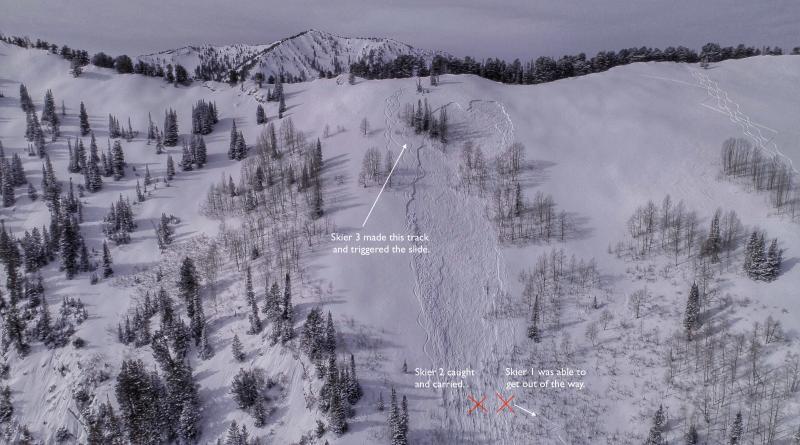
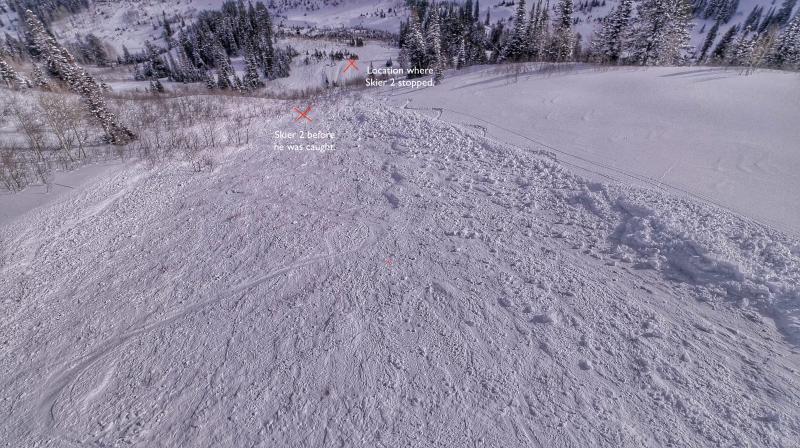
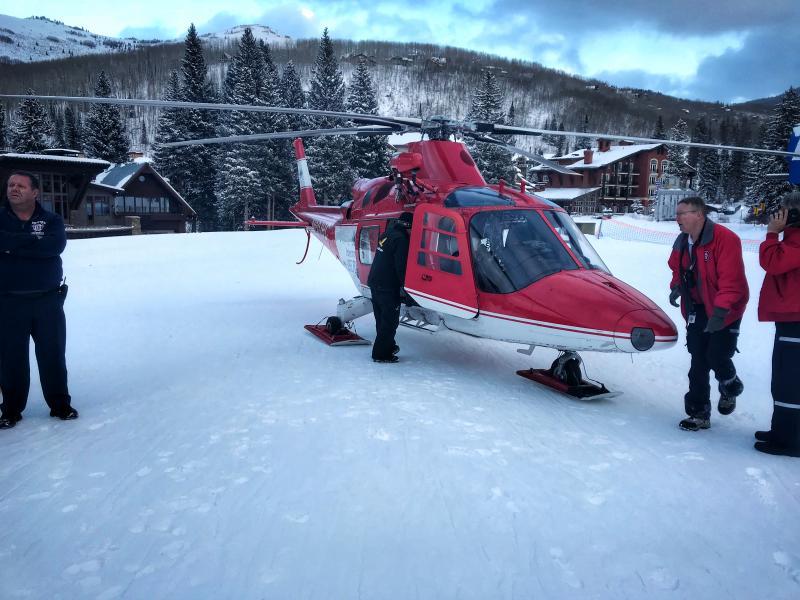
The slope that avalanched is in the Upper Meadow Cutes area of Silver Fork Canyon (it can be found on the Wasatch Backcountry Skiing Map). It's an easterly facing slope with variations of convexities and concavities, the top of the slope is comprised of a long ridge that mainly runs north to south with many popular backcountry skiing runs off this ridge. This particular slope starts out lower angled but quickly breaks over to 38 degrees in steepness. The starting zone does have a northerly component to the slope making it more northeast rather than east like many of the other runs nearby. The slope maintains a slope angle of 33 degrees before flattening out to a bench. Below this bench is a very steep break over that ends in another flat section (terrain trap) before reaching the summer road. This lower bench is 45-50 degrees in slope steepness and has many shrubs, small aspen trees, and small scattered pines which could result in severe consequences if carried through this terrain.
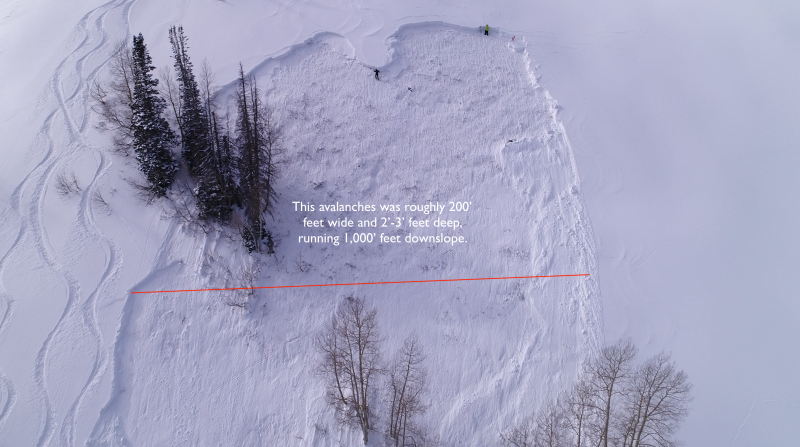
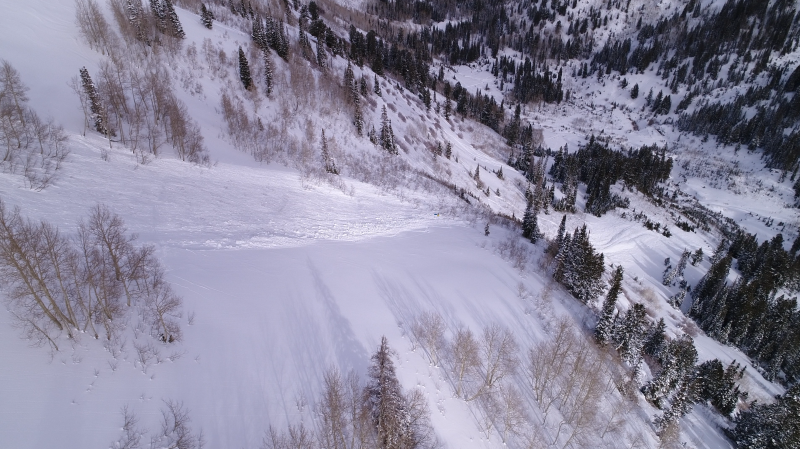
This avalanche happened on Friday, Jan 26 at 3 p.m. A representative weather station four miles to the NW on Reynolds Peak, strong south winds blew from Wednesday afternoon until Thursday afternoon (Jan 24 - Jan 25). They were averaging 20-40 mph with gusts up to 65 mph. (See graph below)
Snowfall began after these strong south winds ended in the afternoon of Jan 25. Most of the snow fell that afternoon and evening.
- Snow containing 0.4 inches of snow water equivalent fell at the Spruces station at 7402 feet.
- Snow containing 0.64 inches of snow water equivalent fell at the Collins station at 9662 feet.
On the morning of the avalanche, winds at the Reynolds station were blowing westerly 10-15 mph with gusts up to 20 mph.
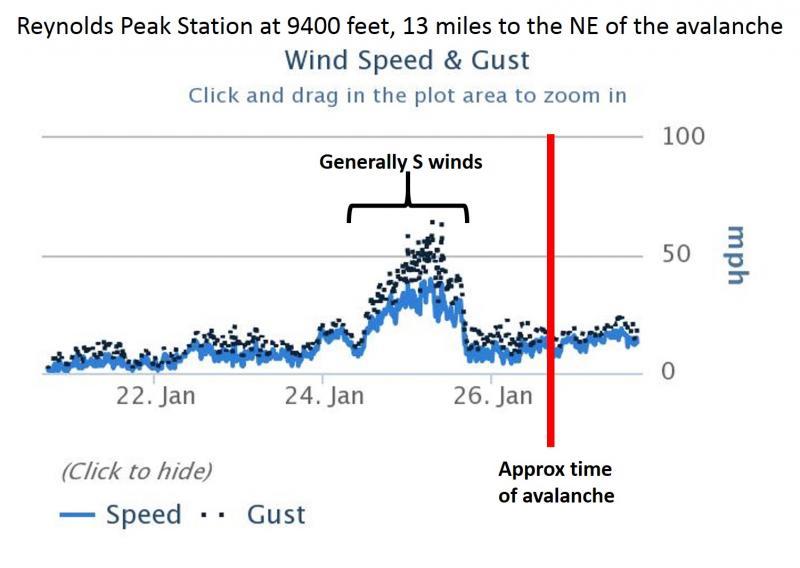
Strong prefrontal southerly winds on January 24th & 25th along with the new snow late in the day Thursday (25th) added additional weight and stress to this slope. All it needed was a trigger. Total height of the snowpack was 110cm (43").
The avalanche failed on a layer of weak sugary faceted snow just above the Thanksgiving heat crust located 75cm (30") down from the surface of the snow. This layer of faceted snow was formed in late November and early December. Subsequent storms have since buried and preserved this weak layer. The average size of the crown was 2.5'-3' feet deep with one section closer to 4'. It was 200' feet wide and ran 1,000' vertical feet.
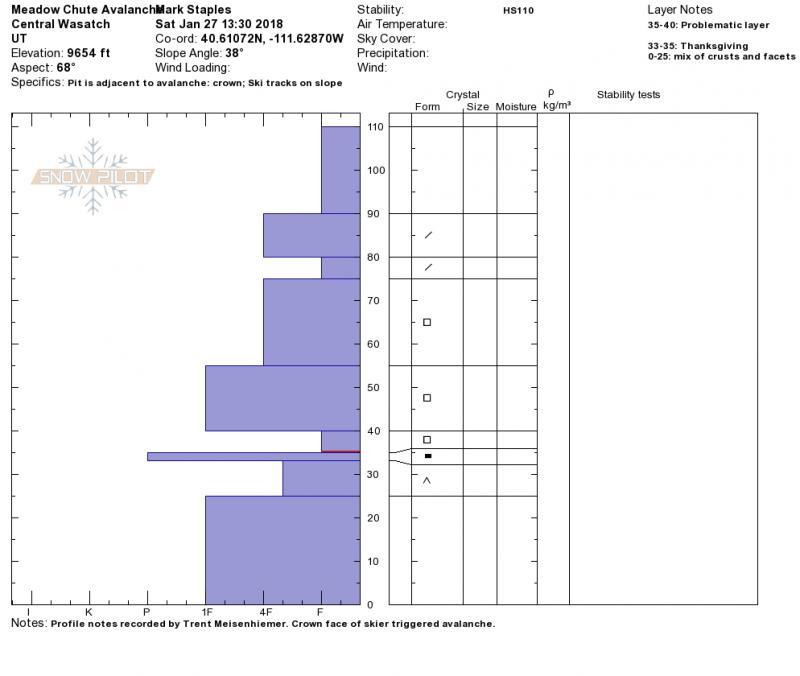
A couple of initial comments about this accident.
- The rescue and the response to this avalanche happened incredibly fast. It was 2 hours from the time the avalanche happened until Skier 2 was delivered to an ambulance. He sat in the snow for 2 hours getting colder by the minute. ALWAYS BE PREPARED BECAUSE IT COULD TAKE MUCH LONGER if you don't have reception for your cell phone, if a helicopter is not immediately available, if there is not a good landing zone nearby (the helicopter landed right next to this skier), if there is bad weather or darkness, or any other number of reasons that complicate rescue.
- This group has a huge amount of experience skiing in the backcountry, well over 60 years. It's very tricky to accurately assess stability.
- This was their 6th run in the area. Don't trust the snowpack we have this year because there are a lot of booby traps out there.
- With persistent slab avalanches and remotely triggered slides, runout zones include terrain beneath adjacent slide paths.
- DON'T STAND IN RUNOUT ZONES.
From one of the members of the party - "Skier 1" - Thanks for the excellent write up with further recollection, it was our 6th run.also one takeaway from this is do not let your guard down,and try to stay away from all runout zones not just the ones you are skiing. I was very lucky!!!! But was on point ready to scamper as I did . I am sure I was missed by just a few feet.
Via email -
I noticed something in your excellent report on the accident in Silver Fork, which I thought worth mentioning. It's clear in the images that the slope had been skied many times prior to the wind/water event of 1/24-25. The old tracks do not follow 'Skier 1's' more conservative line, but dump right over that nasty roll. This might be an illustration of the common mistake of thinking you (I) made an OK decision because we (I) skied something and it didn't avalanche. It creeps me out to consider how many times in my ski career I was a gnat's eyelash from tripping the trigger. Another great reason not to judge other's mistakes through the lens of hindsight. I hate and fear that slope. Perhaps because I remotely triggered a similar slide onto my ski partner, Doug C., in 1984 (the year not the book). Doug was standing on the same bench as Skier 1 and 2. However he was well to the south near the large conifers and scampered further south and hid behind a large tree trunk as my handiwork went past. Unfortunately, we did not learn our lesson and Doug was killed a year later in Water Hollow. I miss him. I'm not sure how useful this comment might be. But perhaps it will, if shared, help people make better decisions and ski with humility; two things I struggle with every winter. Thank you for your quality work. Sincerely, Fred Henion



